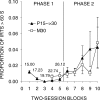The effect of changes in criterion value on differential reinforcement of low rate schedule performance
- PMID: 20354598
- PMCID: PMC2732329
- DOI: 10.1901/jeab.2009.92-181
The effect of changes in criterion value on differential reinforcement of low rate schedule performance
Abstract
The differential reinforcement of low rate (DRL) schedule is commonly used to assess impulsivity, hyperactivity, and the cognitive effects of pharmacological treatments on performance. A DRL schedule requires subjects to wait a certain minimum amount of time between successive responses to receive reinforcement. The DRL criterion value, which specifies the minimum wait time between responses, is often shifted towards increasingly longer values over the course of training. However, the process invoked by shifting DRL values is poorly understood. Experiment 1 compared performance on a DRL 30-s schedule versus a DRL 15-s schedule that was later shifted to a DRL 30-s schedule. Dependent measures assessing interresponse time (IRT) production and reward-earning efficiency showed significant detrimental effects following a DRL schedule transition in comparison with the performance on a maintained DRL 30-s schedule. Experiments 2a and 2b assessed the effects of small incremental changes vs. a sudden large shift in the DRL criterion on performance. The incremental changes produced little to no disruption in performance compared to a sudden large shift. The results indicate that the common practice of incrementing the DRL criterion over sessions may be an inefficient means of training stable DRL performance.
Keywords: differential reinforcement of low rate schedule; interresponse time; rats; timing.
Figures











Similar articles
-
Timing and space usage are disrupted by amphetamine in rats maintained on DRL 24-s and DRL 72-s schedules of reinforcement.Psychopharmacology (Berl). 2009 Jun;204(2):213-25. doi: 10.1007/s00213-008-1451-x. Epub 2009 Jan 14. Psychopharmacology (Berl). 2009. PMID: 19142629 Free PMC article.
-
Antagonism by CGS 8216 and Ro 15-1788, benzodiazepines antagonists, of the action of chlordiazepoxide on a timing behavior in rats.Pharmacol Biochem Behav. 1984 Sep;21(3):381-5. doi: 10.1016/s0091-3057(84)80099-4. Pharmacol Biochem Behav. 1984. PMID: 6093150
-
Differential effects of imipramine in rats as a function of DRL schedule value.Pharmacol Biochem Behav. 1980 Nov;13(5):691-4. doi: 10.1016/0091-3057(80)90013-1. Pharmacol Biochem Behav. 1980. PMID: 7443738
-
Antidepressant effects assessed using behavior maintained under a differential-reinforcement-of-low-rate (DRL) operant schedule.Neurosci Biobehav Rev. 2005;29(4-5):785-98. doi: 10.1016/j.neubiorev.2005.03.018. Neurosci Biobehav Rev. 2005. PMID: 15893376 Review.
-
Neural basis of operant behaviors maintained on the differential-reinforcement-of-low-rate (DRL) schedule in rodents.Brain Res Bull. 2022 Jul;185:1-17. doi: 10.1016/j.brainresbull.2022.04.003. Epub 2022 Apr 16. Brain Res Bull. 2022. PMID: 35439572 Review.
Cited by
-
Differential reinforcement of low rates differentially decreased timing precision.Behav Processes. 2018 Jun;151:111-118. doi: 10.1016/j.beproc.2018.02.022. Epub 2018 Mar 30. Behav Processes. 2018. PMID: 29608943 Free PMC article.
-
Early Alterations in Operant Performance and Prominent Huntingtin Aggregation in a Congenic F344 Rat Line of the Classical CAGn51trunc Model of Huntington Disease.Front Neurosci. 2018 Jan 25;12:11. doi: 10.3389/fnins.2018.00011. eCollection 2018. Front Neurosci. 2018. PMID: 29422836 Free PMC article.
-
KU32 prevents 5-fluorouracil induced cognitive impairment.Behav Brain Res. 2017 Jun 30;329:186-190. doi: 10.1016/j.bbr.2017.03.042. Epub 2017 Mar 27. Behav Brain Res. 2017. PMID: 28359881 Free PMC article.
-
Mechanisms of Individual Differences in Impulsive and Risky Choice in Rats.Comp Cogn Behav Rev. 2015;10:45-72. doi: 10.3819/ccbr.2015.100003. Comp Cogn Behav Rev. 2015. PMID: 27695580 Free PMC article.
-
Mechanisms of impulsive choice: Experiments to explore and models to map the empirical terrain.Learn Behav. 2023 Dec;51(4):355-391. doi: 10.3758/s13420-023-00577-1. Epub 2023 Mar 13. Learn Behav. 2023. PMID: 36913144 Free PMC article. Review.
References
-
- Bizot J.C. Effects of various drugs including organophosphorus compounds (OPC) and therapeutic compounds against OPC on DRL responding. Pharmacology, Biochemistry and Behavior. 1998;59:1069–1080. - PubMed
-
- Britton K.T, Koob G.F. Effects of corticotropin releasing factor, desipramine and haloperidol on a DRL schedule of reinforcement. Pharmacology, Biochemistry and Behavior. 1989;32:967–970. - PubMed
-
- Brown S.W, Boltz M.G. Attentional processes in time perception: Effects of mental workload and event structure. Journal of Experimental Psychology: Human Perception and Performance. 2002;28:600–615. - PubMed
-
- Buhusi C.V, Meck W.H. Differential effects of methamphetamine and haloperidol on the control of an internal clock. Behavioral Neuroscience. 2002;116:291–297. - PubMed
Publication types
MeSH terms
Grants and funding
LinkOut - more resources
Full Text Sources

